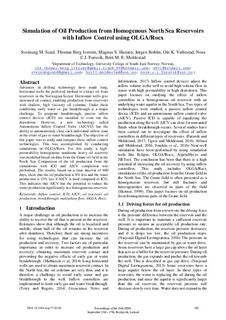| dc.contributor.author | Sund, Sveinung Martinius | |
| dc.contributor.author | Iversen, Thomas Berg | |
| dc.contributor.author | Hansen, Magnus S. | |
| dc.contributor.author | Bohlin, Jørgen | |
| dc.contributor.author | Vøllestad, Ole Kristian | |
| dc.contributor.author | Furuvik, Nora Cecilie Ivarsdatter | |
| dc.contributor.author | Halvorsen, Britt | |
| dc.date.accessioned | 2017-12-13T12:15:59Z | |
| dc.date.available | 2017-12-13T12:15:59Z | |
| dc.date.created | 2017-10-11T17:56:15Z | |
| dc.date.issued | 2017 | |
| dc.identifier.citation | Linköping Electronic Conference Proceedings. 2017, (138), 188-195. | nb_NO |
| dc.identifier.issn | 1650-3686 | |
| dc.identifier.uri | http://hdl.handle.net/11250/2471161 | |
| dc.description.abstract | Advances in drilling technology have made long, horizontal wells the preferred method to extract oil from reservoirs in the Norwegian Sector. Early water or gas breakthrough is a passive inflow control devices (ICD) are installed to even out the drawdown. However, a new technology called Autonomous Inflow Control Valve (AICV©) has the ability to autonomously close each individual inflow zone in the event of gas or water breakthrough. The objective of this paper was to study and compare these inflow control technologies. This was accomplished by conducting simulations in OLGA/Rocx. For this study, a high-permeability homogenous sandstone heavy oil reservoir was modelled based on data from the Grane oil field in the North Sea. Comparison of the oil production from the simulations with ICD and AICV completion was performed. The results, based on a time interval of 600 days, show that the oil production is 8% less and the water production is 43% less if AICV is used compared to ICD. This indicates that AICV has the potential to reduce the water production significantly in a homogeneous reservoir. | nb_NO |
| dc.language.iso | eng | nb_NO |
| dc.rights | Navngivelse-Ikkekommersiell 4.0 Internasjonal | * |
| dc.rights.uri | http://creativecommons.org/licenses/by-nc/4.0/deed.no | * |
| dc.title | Simulation of Oil Production from Homogenous North Sea Reservoirs with Inflow Control using OLGA/Rocx | nb_NO |
| dc.type | Journal article | nb_NO |
| dc.type | Peer reviewed | nb_NO |
| dc.description.version | publishedVersion | nb_NO |
| dc.source.pagenumber | 188-195 | nb_NO |
| dc.source.journal | Linköping Electronic Conference Proceedings | nb_NO |
| dc.source.issue | 138 | nb_NO |
| dc.identifier.doi | 10.3384/ecp17138188 | |
| dc.identifier.cristin | 1503937 | |
| cristin.unitcode | 222,58,3,0 | |
| cristin.unitname | Institutt for prosess-, energi- og miljøteknologi | |
| cristin.ispublished | true | |
| cristin.fulltext | original | |
| cristin.qualitycode | 1 | |

